Always, proofread all citations and the bibliography before you submit your paper or publication. Neither Word nor Mendeley will warn you if there’s a problem with a citation or if data is missing from a particular source. Mendeley will do most of the work for you, but it’s ultimately your responsibility to make sure it looks right.
This article shows how to manage your Mendeley library from the Mendeley website. You can do all these steps and more using the desktop app for Mac, Windows, or Linux, and most of it can also be accomplished on Mendeley Mobile for smartphones and tablets.
First, find the library.

Source: mendeley.com
Either open your Mendeley app or go to Mendeley and click on the My Library tab. A window opens that vaguely resembles an email inbox, with a list of folders on the left and any documents you’ve already stored on the right.
Add new documents.
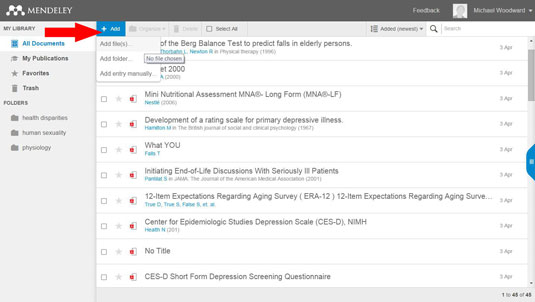
Source: mendeley.com
To add new files to your collection, click on + Add. From here, you have three options:
Add file(s). . . Grab one or more files from your storage drive.
Add folder. . . Create a new folder in which to store documents on specific topics.
Add entry manually. Use this option to enter info about a source for which you do not have the PDF file to attach.
For this example, choose Add file(s) and then select a file from your directory when the dialog box appears.
You can choose more than one file to add. Just choose the first file then press and hold the Ctrl button while you select additional files. Once you have all the files selected, click on Open, and Mendeley will import them into your library.
In the Desktop version, you can also simply drag and drop a file onto the library and Mendeley will create a new record. You can’t do this in the web version to generate a new record, however, but you can drag a file to attach to an existing record.
One other way to capture a source is to use the optional Mendeley Web Importer, a web browser add-in that lives on your bookmarks toolbar. When it’s installed, you just click Save to Mendeley when you have a page or document open in your browser that you want to save as to your Mendeley library.
Complete the document details.
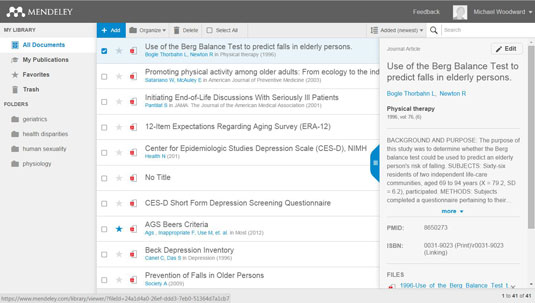
Source: mendeley.com
After you’ve loaded the file, it will appear in your library as a new listing. Click on the new entry. On the right side of the screen, a tab will appear displaying the source details. If the document was able to be interpreted by Mendeley, you should see the title, authors, the type of article, where it was published, an abstract of the article, and more. Yet another magic Mendeley feature.
In some cases, all this information comes through perfectly and you need to do nothing more. But usually there’s something missing. Click on Edit to fill in whatever details might be missing. You may have to hunt some of this information down elsewhere and plug it in, but most of it you can likely find buried somewhere in the document itself.
To open the document (usually a PDF) for review, click on the small file icon at the left end of the document record.
You must have an application on your computer that will read the file type. For example, if the file is a PDF, you need Adobe Acrobat Reader or another kind of PDF file reader. Just close the tab when you’re done reviewing the file.
Click on Save to store your edits to the record. The changes will immediately show in the record; they will be synced with any other installation of Mendeley you’re running (such as on your tablet) the next time you open it there.
Need to import an entire library?

Source: mendeley.com
If you’re porting your entire research library over to Mendeley from another application, you’ll first need to export the library from the old app to an .xml (EndNote format), .bib or .ris file. Then in Mendeley Desktop (not the web version), click on File, Import, and then select the file format from the drop-down menu. Mendeley will open a dialog box so you can locate and select the file to import.
Sort the library.

Source: mendeley.com
You can reorder the way your library entries appear. Click the sort button on the right side of the Mendeley toolbar. You can choose to sort the files by when they were added (from oldest to newest, or vice versa), or you can sort them in alphabetical or reverse alphabetical order.
Search for a specific entry or file.
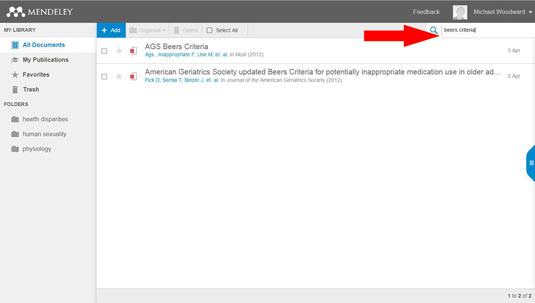
Source: mendeley.com
To find a specific file or group of files, click in the Search box and type a few key words, the title, author, or anything else in the record. Then click on the magnifying glass or simply press Enter. Mendeley will display all the records it finds that contains your search string.
Organize the documents into folders.
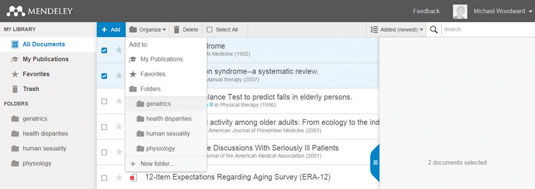
Source: mendeley.com
Now that you’ve found the specific files you were looking for, you might want to move them to a separate folder so you don’t have to dig through the whole library again. Select the file(s) you want to move and then click on Organize.
The Add to: drop-down menu will appear. Here you can choose existing folders in which to store the records, or you can create a new folder.
Delete records and files you don’t need.
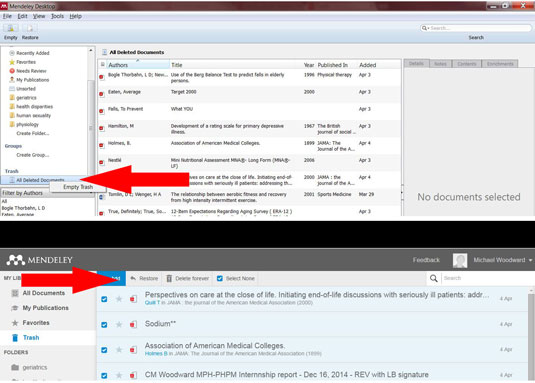
Source: mendeley.com
If you’re like most people, you hang on to more stuff than you actually end up using in the long run. After you’re done with the project, it’s not a bad idea to get rid of all the extra files unless there’s potential that you’ll need them some other time.
It’s easy to delete a library record or file: select it and press Delete. (In Mendeley Web, select it and click on Delete in the toolbar.)
If you accidentally delete a record or file, don’t panic — you can still get it back. Files and records you delete remain in the Trash until you empty it. (No surprises — the garbage doesn’t take itself out at home, either). Go to the Trash folder, select the item and click on Restore.
Mendeley gives you a generous 2 GB of free storage for your library, but that can add up quickly. The quickest ways to dump the space hogs? One of these:
In Mendeley Desktop: Scroll down in the list of folders on the left and find the Trash. Right-click on All Deleted Documents and choose Empty Trash, then sync your library to ensure the files are not retained by the other devices synced to your account.
In Mendeley Web: Click on the Trash folder, choose Select All from the toolbar, and then click on Delete Forever.






